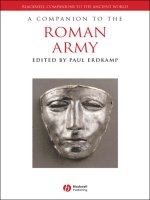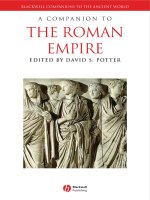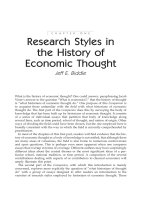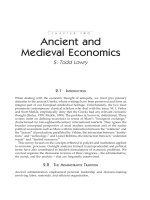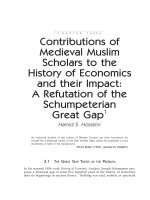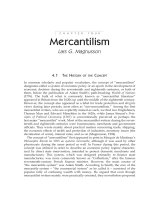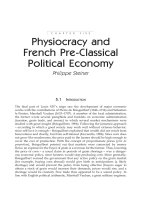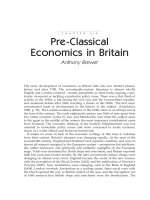A Companion to the City Edited by Gary Bridge and Sophie Watson.. pot
Bạn đang xem bản rút gọn của tài liệu. Xem và tải ngay bản đầy đủ của tài liệu tại đây (6.44 MB, 658 trang )
A Companion to the City
Edited by
Gary Bridge and Sophie Watson
A Companion to the City
Edited by
Gary Bridge and Sophie WatsonContents
List of Contributors ix
List of Illustrations xi
Introduction 1
Part I Imagining Cities 5
1 City Imaginaries 7
Gary Bridge and Sophie Watson
2 Three Urban Discourses 18
John Rennie Short
3 Putting Cities First: Remapping the Origins of Urbanism 26
Edward W. Soja
4 Photourbanism: Planning the City from Above and from Below 35
Anthony Vidler
5 The Immaterial City: Representation, Imagination, and Media
Technologies 46
James Donald
6 Imagining Naples: The Senses of the City 55
Lesley Caldwell
7 The City as Imperial Centre: Imagining London in Two
Caribbean Novels 65
Riad Akbur
8 Sleepwalking in the Modern City: Walter Benjamin and
Sigmund Freud in the World of Dreams 75
Steve Pile
9 Contested Imaginings of the City: City as Locus of Status,
Capitalist Accumulation, and Community: Competing
Cultures of Southeast Asian Societies 87
Patrick Guinness
Part II The Economy and the City 99
10 City Economies 101
Gary Bridge and Sophie Watson
11 The Economic Base of Contemporary Cities 115
Ash Amin
12 Flexible Marxism and the Metropolis 130
Andy Merrifield
13 Monocentric to Policentric: New Urban Forms and Old
Paradigms 141
William A. V. Clark
14 Ups and Downs in the Gobal City: London and New York
at the Millennium 155
Susan S. Fainstein and Michael Harloe
15 Analytic Borderlands: Economy and Culture in the Global
City 168
Saskia Sassen
16 Turbulence and Sedimentation in the Labor Markets of Late
Twentieth-Century Metropoles 181
Nick Buck and Ian Gordon
17 Informational Cities: Beyond Dualism and Toward
Reconstruction 192
Bob Catterall
18 Diaspora Capital and Asia Pacific Urban Development 207
Chung Tong Wu
19 Capitalizing on Havana: The Return of the Repressed in a
Late Socialist City 224
Charles Rutheiser
20 Urban Transformation in the Capitals of the Baltic States:
Innovation, Culture and Finance 237
Philip Cooke, Erik Terk, Raite Karnite, Giedrius Blagnys
Part III Cities of Division and Difference 249
21 City Differences 251
Gary Bridge and Sophie Watson
22 Postcolonialism, Representation, and the City 261
Anthony D. King
vi CONTENTS
23 Cities in Quarters 270
Peter Marcuse
24 Citizenship, Multiculturalism, and the European City 282
Alisdair Rogers
25 Working out the Urban: Gender Relations and the City 292
Liz Bondi and Hazel Christie
26 The Sexual Geography of the City 307
Frank Mort
27 From the Other Side of the Tracks: Dual Cities, Third Spaces,
and the Urban Uncanny in Contemporary Discourses of
``Race'' and Class 316
Phil Cohen
28 Gentrification, Postindustrialism, and Industrial and
Occupational Restructuring in Global Cities 331
Chris Hamnett
29 Worlds Apart and Together: Trial by Space in Istanbul 342
Kevin Robins and Asu Aksoy
30 Value Conflicts, Identity Construction, and Urban Change 354
Lily L. Kong
Part IV Public Cultures and Everyday Space 367
31 City Publics 369
Gary Bridge and Sophie Watson
32 Reflections on the Public Realm 380
Richard Sennett
33 City Life and the Senses 388
John Urry
34 With Child to See Any Strange Thing: Everyday Life in the
City 398
Nigel J. Thrift
35 Walter Benjamin, Urban Studies, and the Narratives of City
Life 410
Michael Keith
36 ``X Marks the Spot: Times Square Dead or Alive?'' 430
M. Christine Boyer
37 Walking and Performing ``the City'': A Melbourne Chronicle 437
Benjamin Rossiter and Katherine Gibson
38 The Street Politics of Jackie Smith 448
John Paul Jones III
CONTENTS vii
39 Wonderful, Terrible: Everyday Life in Bangkok 460
Annette Hamilton
40 Street Boys in Yogyakarta: Social and Spatial Exclusion in
the Public Spaces of the City 472
Harriot Beazley
41 Cyberspace and the City: The ``Virtual City'' in Europe 489
Alessandro Aurigi and Stephen Graham
Part V Urban Politics and Urban Interventions 503
42 City Interventions 505
Gary Bridge and Sophie Watson
43 Planning in Relational Space and Time: Responding to
New Urban Realities 517
Patsy Healey
44 The Social Construction of Urban Policy 531
Allan D. Cochrane
45 Urban Planning in the Late Twentieth Century 543
Patrick Troy
46 Varied Legacies of Modernism in Urban Planning 555
Alan Mabin
47 The Environment of the City or the Urbanization of
Nature 567
Erik Swyngedouw and Maria Kaõ
È
ka
48 Power and Urban Politics Revisited: The Uses and Abuses of
North American Urban Political Economy 581
Alan Harding
49 Social Justice and the City: Equity, Cohesion and the Politics
of Space 591
Fran Tonkiss
50 Property Markets and the Production of Inequality 599
Michael Edwards
51 The Politics of Universal Provision of Public Housing 609
Chua Beng Huat
52 Reintegrating the Apartheid City? Urban Policy and Urban
Restructuring in Durban 617
Alison Todes
Index 630
viii CONTENTS
Contributors
Riad Akbur has completed 3 years of a PhD at Queen Mary and Westfield College,
University of London
Asu Aksoy Goldsmith's College, University of London
Ash Amin University of Durham
Alessandro Aurigi University College, London
Harriot Beazley Visiting Scholar at the University of Cambridge
Giedrius Blagnys Ecofin Vilnius Research Centre, Vilnius, Lithuania
Liz Bondi University of Edinburgh
M. Christine Boyer Princeton University
Gary Bridge University of Bristol
Nick Buck University of Essex
Lesley Caldwell University of Greenwich
Bob Catterall University of Newcastle
Hazel Christie Edinburgh College of Art and Heriot-Watt University
William Clark University of California, Los Angeles
Allan Cochrane The Open University
Phil Cohen University of East London
Philip Cooke University of Wales, Cardiff
James Donald Curtin University of Technology, Western Australia
Michael Edwards University College, London
Susan Fainstein Rutgers University
Katherine Gibson Australian National University, Canberra
Ian Gordon University of Reading
Stephen Graham University of Newcastle
Patrick Guinness Australian National University
Annette Hamilton Macquarie University in Sydney
Chris Hamnett King's College, London
Alan Harding Salford University
Michael Harloe Salford University
Patsy Healey University of Newcastle
Chua Beng Huat Singapore National University
John Paul Jones III University of Kentucky
Maria Kaika Associate Researcher at the University of Oxford, Junior Research
Fellow at Linacre College, Oxford, and Lecturer at St. Peter's College, Oxford
Raite Karnite Latvian Academy of Sciences, Riga, Latvia
Michael Keith Goldsmith's College, University of London
Anthony D. King Binghamton University, State University of New York
Lily Kong National University of Singapore
Alan Mabin Witwatersrand University, Johannesburg
Peter Marcuse Columbia University, New York City
Andy Merrifield Clark University
Steve Pile The Open University
Kevin Robins Goldsmith's College, University of London
Alisdair Rogers Keble and St. Catherine's Colleges, Oxford University
Benjamin Rossiter studied sociology and cultural studies at La Trobe and Monash
Universities, Melbourne, and recently finished his PhD
Charles Rutheiser Johns Hopkins University
Saskia Sassen University of Chicago and Centennial Visiting Professor at London
School of Economics and Political Science
Richard Sennett London School of Economics and Political Science
John Rennie Short Syracuse University
Edward W. Soja University of California, Los Angeles
Erik Swyngedouw Reader in Geography at Oxford University and Fellow of St.
Peter's College, Oxford
Erik Terk Estonian Institute for Future Studies, Tallinn, Estonia
Nigel Thrift University of Bristol
Alison Todes University of Natal, Durban
Fran Tonkiss Goldsmith's College, University of London
Patrick Troy Australian National University
John Urry University of Lancaster
Anthony Vidler University of California, Los Angeles
Sophie Watson
Chung-Tong Wu University of New South Wales
x CONTRIBUTORS
The Open University
Illustrations
1.1 Aboriginal inscription, Sydney (Steve Pile) 11
1.2a/b Sidewalk dwellers, Johannesburg (Sophie Watson) 12
3.1 Reconstruction and original of cityscape painting at CË atal Hu
È
yu
È
k
(top: James Mellaart, CË atal Hu
È
yu
È
k, 1967, plate 60; bottom: de la
Croix, Tansey, and Kirkpatrick, Art through the Ages, 9th edn,
New York: Harcourt Brace Jovanovich, 1991: 46, figure 2±8, land-
scape with volcanic eruption (?), detail of a copy of a wall painting
from Level VII, CË atal Hu
È
yu
È
k, ca. 6150 bc)31
8.1 Heavenly Dinner (# Sygma-Keystone-Paris 1989) 78
8.2 Paris Street: Rainy Day, (Gustave Caillebotte, 1848±1894; oil on
canvas, 212.2 Â 276.2 cm; Charles H. and Mary F. S. Worcester
Collection, 1964.336; Photograph copyright # 2000 The Art
Institute of Chicago) 83
9.1 A poor kampung by the river edge in Yogyakarta (Harriot Beazley) 91
10.1 Hairdressing salon, South African township (Sophie Watson) 103
10.2 Chicago (Steve Pile) 108
13.1 Hypothetical monocentric and policentric urban structures (a:
adapted from Bourne (1981); b: adapted from Cadwallader
(1996)) 144
13.2 The Southern California urban region 148
13.3 Edge cities in Los Angeles/Orange Counties and population change
1970±1990. (Standardized selected census tract comparison) 149
14.1 New York (Steve Pile) 156
17.1 The cosmopolite development model? An interpretation by the
King's Cross Railwaylands Community Group of the London
Regeneration Consortium's and British Rail proposal for King's
Cross (from Michael Parkers, ``Planning Prospects, Planning Edu-
cation,'' in Regenerating Cities, 3 and 4, p. 23) 199
18.1 Hong Kong skyline (Sophie Watson) 208
18.2 Hong Kong island (Sophie Watson) 209
18.3 Cabramatta ± Chinese-Vietnamese locality, Sydney (Steve Pile) 214
19.1 Havana and its neighborhoods 226
19.2 Historic Center of Havana 231
21.1 Aboriginal mural, Sydney (Steve Pile) 251
21.2 A tale of two cities? Cape Town (Sophie Watson) 252
26.1 Sydney gay and lesbian Mardi Gras parade (Steve Pile) 312
31.1 Street barber in Hanoi (Sophie Watson) 375
35.1 Christ's Entry into Brussels in 1889 (James Ensor, oil on canvas,
1888, 252.5 Â 430.5 cm. The J. Paul Getty Museum, Los Angeles) 417
37.1 Art-stronaut Andrew Morrish has his daily headshave under the
watchful eye of early morning shoppers (photo: Angela Wiley;
from The Age, October 19, 1996) 442
37.2 In their ``living room'' the Urban Dream Capsule art-stronauts
perform for a Festival audience (photo: Penny Stephens; from Sun-
day Age, November 3, 1996) 444
38.1 Location of the Lorraine Motel, site of the National Civil Rights
Museum in Memphis, Tennessee # John Paul Jones III 449
38.2 King's assassination at the Lorraine (Photo by Joseph Louw/LIFE
magazine # TIME Inc. used with permission.) 450
38.3 Historical marker describing the significance of the Lorraine Motel
# John Paul Jones III 450
38.4 The National Civil Rights Museum. At left is the entrance to the
museum # John Paul Jones III 451
38.5 The balcony outside the preserved wing of the motel. The auto-
mobiles reference the cars captured in Joseph Louw's photograph
(Figure 38.2) # John Paul Jones III 452
38.6 Jacqueline ``Jackie'' Smith protests the Lorraine's transformation
into a museum # John Paul Jones III 452
38.7 Jackie asks Memphis residents and visitors to boycott the museum
# John Paul Jones III 453
38.8 The museum is a site for some of the city's cultural events # John
Paul Jones III 455
38.9 The street between Jackie and the museum is regularly traversed by
vehicles, such as this one, carrying tourists # John Paul Jones III 456
38.10 The sign records the number of consecutive days Jackie has pro-
tested. This photograph was taken in 1995. As of this writing, she
is still there # John Paul Jones III 456
38.11 Memphis visitors inquire about the protest # John Paul Jones III 457
40.1 Yogykarta, central Java: population 472,000. Malioboro street
runs through the center of the city, from the railroad station
towards the Alun-Alun (City Square) and Keraton (Sultan's Palace) 474
40.2 Shoe-shiners on Malioboro (Harriot Beazley) 475
40.3 City-square kids (Harriot Beazley) 476
40.4 Bambang's (aged 11) map of Yogyakarta: Focus is on the Malio-
boro and toilet area, as well as ngebong (Gerbong), by the train
tracks; Sosrowijayan Street (where tourists and backpackers stay);
Sopeng (the local market); and the Alun-Alun (City Square) 479
xii ILLUSTRATIONS
40.5 Sorio's (aged 10) map of Yogyakarta. Sorio has drawn the toilet
area (top left of the map), the railroad station and railroad tracks.
Malioboro street runs through the centre of the map. Sorio perso-
nalizes his account by drawing a train on to his map, as well as
food stalls, a horse-drawn cart, and children playing under the tree
outside the toilet on Malioboro (note that one of the children is
carrying a tambourine for busking) 480
40.6 Agus's (aged 12) map of Yogyakarta. The letters and numbers
relate to the numbered bays at the bus terminal, and the lines are
the bus routes which branch out from the terminal and run through
the city 480
40.7 Hari's (aged 15) map of Yogyakarta. As well as Shoping (the local
market) and the WC (toilet) on Malioboro, the map shows the bus
stops and bus routes on which Hari worked: Korem/Tempat Nga-
men (Korem/busking place, the numbers relate to the bus/route
numbers); and Naik Bis. He also marks Cokro (the NGO Girli's
open house); Lisa (a favourite food stall) and the Tempat anak
tidur (``the place where the children sleep'') on Malioboro; Sosro
(the tourist street); the stasiun (railroad station) and Gerbong
(depicted by a gerbong/railroad car), and Rel Kereta (train tracks).
(Note: the writing on the map is my own as Hari cannot read or
write, and he asked me to mark the map as he instructed.) 482
40.8 Edo's (aged 16) map of Yogyakarta. Edo has marked the toilet on
Malioboro, Rumah Girli (NGO open house); the Alun-Alun (City
Square); Shoping (local market); kantor polisi (police station);
Bioskop Permata (a cinema); two prapatans (traffic light intersec-
tions); the Taman (City Park); the THR (the People's Entertainment
Park); and the stasiun (railroad station). Note the prominence of
the Rel Kereta Api, ``the railroad tracks'' running through the city 483
41.1 The Internet interface for De Digitale Stadt, Amsterdam, one of the
best-known examples of a ``grounded'' virtual city which uses the
urban metaphor of ``town squares'' to organize its services (at
491
41.2 Cybertown, a ``non-grounded'' virtual city (at er-
town.com) 491
41.3 ``Ideal types'' of virtual city 495
41.4 City-related Internet sites in the EU, 1997 496
41.5 Distribution of virtual city types in the EU by nation, 1997 497
41.6 The Iperbole virtual city, Bologna, an example of an Italian ``holis-
tic'' virtual city (at />me.html) 498
41.7 Relationships between originating institution and type of virtual
city in Italy and the EU 499
43.1 The ``uniplex'' city 518
43.2 Fitting development projects into the ``spatial jigsaw'' 521
43.3 Fitting development projects into the ``institutional jigsaw'' 525
43.4 The ``multiplex'' city 526
ILLUSTRATIONS xiii
44.1 Heron Quay ± London's Docklands (Steve Pile) 537
52.1 A reintegrating city? Racial zoning in Durban under apartheid, and
recent developments 620
52.2 Centrally located informal settlements in Cato Manor, and, adja-
cent, higher-income areas (copyright # Tony Smith Photography) 621
52.3 The Cato Manor Development Project: one of the few opportu-
nities for urban integration (copyright # Tony Smith Photography) 622
xiv ILLUSTRATIONS
Introduction
At the start of the new millennium cities are firmly back on the agenda. More people
live in cities and more people are affected by urban processes than ever before. Cities
are the sites of complex global/local interconnections producing a multiplicity of
social, cultural, political, and economic spaces and forms. It is no longer possible, if
it ever was, to look at the city from one perspective ± be it cultural or economic.
Instead cities need to be understood from a variety of perspectives in the recognition
that the cultural/social constructs, and is constructed by, the political/economic and
vice versa. It is only when we adopt such a complex and textured reading of cities
that we will begin to be able to address the pressing social, economic, and environ-
mental questions faced by cities across the world ± be it the postindustrial city of
North America or the rapidly growing megacity in China.
This Companion sets out precisely to think about cities in these more complex
ways and to bring together scholars from a range of different fields to create a
multidisciplinary approach to cities. No longer is the city the privileged terrain of
urban studies or geographical analysis. Instead academics and thinkers from dis-
ciplines as diverse as film studies and economics or philosophy and geography have
turned their attention to the city and generated exciting new ways of thinking. This
Companion has deliberately included voices from this diverse terrain in order to
promote a dialog that for many years of urban analysis was dormant. Poststructur-
alist and feminist writers thus rub shoulders with Marxists and neoclassical econo-
mists in order, hopefully, to provoke lively debate and new intellectual spaces.
The Companion does not aim to map the field historically or to provide a chrono-
logy of major writing on cities ± there are other excellent readers that do precisely
that (see Le Gates and Stout 1996; Short 1996). Neither does it aim to provide a
geographical catalog of the conditions of contemporary cities, since that is done very
well by Habitat and other regional collections. This Companion instead deals with
contemporary analysis of cities as well as some of the key issues in cities. There has
been a tendency within urban studies historically to develop an analysis and argu-
ment based on Western cities and Western assumptions of cultural, social, and
economic life, with little attention paid to the profound differences of social,
cultural, and economic processes and the local specificity of cities across the world.
This universalizing approach has come under growing criticism and scrutiny from
postcolonial writers, feminists, poststructuralists and others who have pointed out
how western, male, and white assumptions have produced a global homogenous
discourse which has masked and ignored difference. It has also perpetuated domi-
nant power/knowledge relations and written whole groups of people, cities, and
countries out of the picture.
This Companion aims to redress this imbalance. It does not purport to be com-
prehensive in its coverage or analysis of cities across the globe. It does however aim
to consider the key themes of the book in a variety of contexts, places, and spaces. Its
aim therefore is to give a taste at least of the complexity and texture of cities, city
spaces, and city interventions at the beginning of the millennium.
All the chapters in this Companion were commissioned by the editors and are thus
original pieces of work. They range from discursive and reflective pieces to discus-
sions of original empirical research. The Companion is organized around five themes
which we consider to be a useful way of mapping the field: imagining cities, the
economy and the city, division and difference, public cultures and everyday space,
urban policy and interventions. Each of the sections is introduced by a think piece by
the editors which is not intended as an introduction to the chapters in the section, but
rather is an attempt to lay out the dimensions of discussion and suggest new ways of
approaching the city. Each section includes chapters from non-western
1
cities in
order to highlight the variety and diversity of cities and analyses of cities globally
rather than to provide a comprehensive coverage of cities across the world.
Cities are feats of the imagination and they affect the ability to imagine. The first
section, ``Imagining Cities,'' looks at the different ways cities have been imagined in
planning and design as well as media representations and the effects on the built
form and the social, cultural, and esthetic realms. These are not just cognitive and
creative but unconscious and uncanny. They are not just confined to planning and
cultural discourse but influence ways of thinking the economic, identity, and differ-
ence, constructions of the public and the private, and the sphere of politics. Each
section of the Companion is intended to cohere sufficiently to examine the main
currents of discussion within each theme but also to provide openings, connections,
and productive juxtapositions with the other sections of the book. So ``The Economy
and the City'' is not just understood in terms of academic disputes about material
processes (between neoclassical, Marxist, and post-Marxist analyses) but also as
acts of the imagination and political will ± as much the terrain of cultural studies as
conventional political economy. ``Cities of Division and Difference'' explores the
distinctions of age, class, gender, ``race'' and ethnicity, sex, citizenship in relation to
urban space, and the disruptions of western and nonwestern understandings of
productive recognition and prejudiced separation. The extent to which these inter-
relations result in a depleted public realm in cities is a concern that runs through the
chapters in the section ``Public Cultures and Everyday Space.'' Rumors of the death
of public space might be a little exaggerated as the contributors seek the possibilities
of a rejuvenated public realm in the mundane, the unnoticed, and the everyday
practices of city life. These insights give us new ways of thinking about urban
politics and the interrelations between formal, institutional policy-making, and
informal political activity in the uncelebrated spaces of the city.
2 INTRODUCTION
In all these arguments on the city and imagination, economy, division, the public,
and politics we are seeking to unsettle assumptions and cross boundaries, not in the
pursuit of endless displacement, but rather to identify new connections that lie at the
confluence of the imagination as economy, globalization as cultural difference and
as productive, and the political in acts that are normally ignored. These disruptions
and juxtapositions are at the heart of the urban experience and offer a beginning for
a reconstituted understanding of the city in the third millennium.
NOTE
1. There have been a number of ways of regionalizing discussion of cities such as the division
between cities of the north and cities of the south. Here we choose western and non-
western to connote not just geographical location but sets of intellectual histories and
assumptions in traditional literatures on cities.
REFERENCES
Le Gates, R. and Stout, F. (eds.) 1996: The City Reader. London: Routledge.
Short, J. 1996: The Urban Order: An Introduction to Cities, Culture and Power. Oxford:
Blackwell.
INTRODUCTION 3
Part I Imagining Cities
Chapter 1
City Imaginaries
Gary Bridge and Sophie Watson
Cities are not simply material or lived spaces ± they are also spaces of the imagina-
tion and spaces of representation. How cities are envisioned has effects. Urban
designers and planners have ideas about how cities should look, function, and be
lived, and these are translated into plans and built environments. Cities are repre-
sented in literary, art, and film texts, and these too have their effects. The public
imaginary about cities is itself in part constituted by media representations as much
as by lived practices. Ideas about cities are not simply formed at a conscious level;
they are also a product of unconscious desires and imaginaries. This Companion
starts with these city imaginaries to illustrate the power of ideas, the imagination,
representations, and visions in influencing the way cities are formed and lived.
Here we pursue two themes which organize thinking on the relationship between
the city and the imagination: how the city affects the imagination and how the city is
imagined. Although there are obvious links between these two they are a useful way
to think about imagining cities.
The effect of the city on the imagination contains a tension between the conditions
of the city stimulating or constraining the imagination. On the one hand cities are
creative, places that encourage the imagination, sites of stimulation. People with
different ideas come together in cities and their webs of interconnection and sharing
of knowledge and ideas are productive creatively. These ideas have material effects ±
in the form of economic innovation (for example in manufacturing) and profits from
selling ideas in the innovation and informational economy (see, for example, in this
volume Amin, chapter 11, Catterall, chapter 17 ). The idea of the city as a crucible
for ideas and innovation has a long history ± back to the very origins of urbanism in
fact. Soja (chapter 3) argues that the stimulating effects of urban agglomeration
(what he calls synekism) resulted in innovations in cultivation that produced the
agrarian revolution. Here the interactive conditions of the city encourage bright
ideas to overcome settled ways of thinking.
Settled ways of thinking can be powerful acts of the imagination in themselves.
Cities might act to constrain the imagination or to consolidate it in collective
imagination as tradition and authority. Cities, like nations, can be the locus for
imagined communities. This collective imagination might be held in place through
the exercise of discipline and authority. One of Short's three urban discourses
(chapter 2) looks at the city as a source of authority, repression, and compunction.
These influences act as chains on the imagination. On the other hand such an
authoritarian city can be a source of identity and security. The tensions between
authority and identity are evident in Patrick Guinness's account (chapter 9) in which
the figure of the sultan acts as a powerful locus for the imagination on the ``subjects''
of Yogyakarta. In many non-Western cities (and increasingly in many Western ones)
the religious or spiritual imagination is a key locus of identity and impacts on the
built form of the city. This cosmic city (as Short puts it) can come into conflict with
the dominant urban imaginary in the West which is that of capital accumulation.
This also challenges conventional Western views of modernity and the city (via
Weber 1966; Simmel 1995, and others) on the secularization of society and forms
of individual alienation or anomie. If Western urbanism was facilitated by the
individualism that came with a disenchantment with the world, the interaction of
capitalism with other collective imaginations and representations (such as those
based on religious faith) give a more unpredictable mix of confrontation or coopta-
tion of capital and culture, and vice versa.
It is clear that forms of collective imagination can be both positive and negative
(Boyer 1994). Prejudiced imaginaries of ``the other'' are a source of racism, and the
untrammeled domination of certain collective imaginaries work to exclude others ±
as the burgeoning literature on postcoloniality points out (see Akbur, chapter 7;
King, chapter 22). Similarly notions of community assume a homogeneity of popu-
lation and can entail an idea of purification where those designated as outside
become the site of prejudice and segregation. Postcolonial and feminist writing
reveal the degree to which Western imaginaries of the city and the other were
overwhelmingly visual in nature (the colonial gaze, the watching fla
Ã
neur). Anthony
Vidler (chapter 4) shows the extent to which this was true for the conceived space of
the city in Western architecture and planning: Le Corbusier's imagination was fed by
airplane flights above Paris.
The speed of growth and the kaleidoscope of capital and culture in non-Western
cities challenges the visual imaginary through the synesthesia of the city and the
importance of other senses. What makes cities extraordinary is that they contain
sites where the senses are bombarded and these can be read as a source of pleasure:
the Spice Market in Istanbul, or the street markets of Hanoi; or displeasure, as in the
rush-hour spaces of underground stations.
The city in its complexity and abundance of sensory data can also be seen as a
space which contributes to our sense of fragmented subjectivity or overload. In
Simmel's exploration of the relation between the subject's inner life and the city he
suggests that in the modern metropolis the individual becomes saturated with
stimuli: ``There is no psychic phenomenon which is so unconditionally reserved to
the city as the blase
Â
attitude'' ([1903] 1995: 329). Yet with the influence of post-
modernist thought the notion of fractured selves, lives, and complexity has shifted
from being constituted as a negative trope to a more positive one. Thus Simmel's
notion of the city as a site of overstimulation and excess of feeling has been
substituted by an imagination of the city as vibrant and exciting and a space
where the play of the senses and bodily pleasures can be celebrated and explored.
8 GARY BRIDGE AND SOPHIE WATSON
Contemporary discourses of the city as constituting sites of pleasure are perhaps
one of the many reasons that Benjamin's writings have received so much recent
attention by urbanists. For him the city and its crowds are intoxicating, fascinating,
productive, and creative, while the commodity culture of the nineteenth century
is conceived as a dreamworld. The modern metropolis for Benjamin was the
principal site of the phantasmagoria of modernity and the new manifestation of
myth, which is illustrated particularly in his writings on the covered shopping
arcades of Paris which were constructed from glass and intricate ironwork which
shone and sparkled. The dreamworld and unconscious of the bourgeoisie, with its
dreams of progress, abundance, desire for pleasure and consumption are materi-
alized in the architecture, commodities, and fashion of the city. But the city for
Benjamin is also an ambiguous place ± at once alluring and threatening (Buck-Morss
1995: 66):
As a social formation, Paris is a counter image to that which Vesuvius is as a geographic one:
A threatening, dangerous mass, an ever-active June of the Revolution. But just as the slopes of
Vesuvius, thanks to the layers of lava covering them, have become a paradisiacal orchard, so
here, out of the lava of the Revolution, there bloom art, fashion and festive existence as
nowhere else.
His writings are not explorations of memory as such and the metropolis is not
simply a space remembered by Benjamin; rather memory is intricately interwoven
with particular sites (Gilloch 1997: 11, 66). Memory shapes the city at the same time
as being shaped by it.
City and the Realization of Self
So far we have considered the city's effect on the collective imagination. But urban
imagination can also be read in terms of realization or nonrealization of the indi-
vidual ± the self. It was in the ordinary spaces of the city that James Joyce's
characters achieved self-realization ± those epiphanies or moments of insight and
revelation, so extraordinary, came in the everyday spaces of the city. Equally those
urban writers and scholars of the cosmopolitan school look to the encounter with
others as a form of psychic development and enlightenment (Sennett 1970; Young
1990; Jacobs 1962). On the other hand the city and urban experience may also act to
separate the self from imagination and creativity. Alienation is estrangement. For
Marx this was a material process, an outcome of the social relations of production in
capitalism. In this sense much experience for many urban dwellers in western and
non-Western cities is a distance from the imagination and a denial of imagination.
Yet even in the spaces of alienation, shackled to the production line, acts of the
imagination like daydreams form sites of resistance (see Figure 1.1).
This distance from the imagination was enforced through bricks and mortar for
Engels (Engels 1971). In his study of Manchester of 1844 the separation of workers
in different quality housing and separate districts led to the separation of their
imaginations and suppressed the possibility of them coming together to form a
revolutionary consciousness. These city trenches (to borrow Katznelson's 1981
term) are trenches in the imagination. In contemporary cities such trenches take
CITY IMAGINARIES 9

